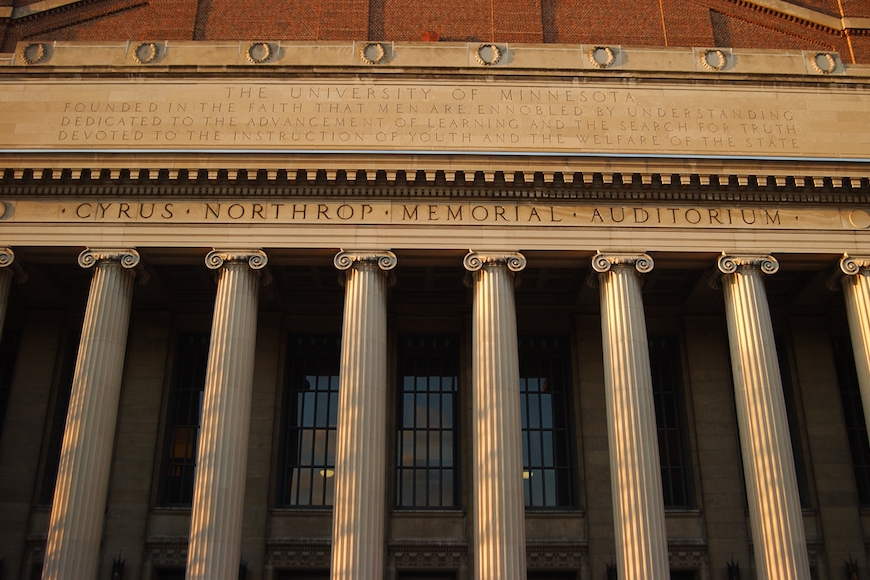Connecting with Community
Land-grant universities such as the University of Minnesota were conceived more than 150 years ago as institutions that would serve the communities around them. In exchange for land and funding, such schools were to teach classical studies, agriculture, science, military science, engineering, and other topics that would contribute to the wisdom, civility, self-sufficiency, and commercial viability of the local community.
Today, the U of M’s mission statement includes a promise to be “conscious of and responsive to the needs of…many communities” and it is one of the first public-research institutions in the country to win the Carnegie Foundation’s prestigious Community Engagement Classification. “Education here has always been about engagement,” says art history professor and associate dean for the arts & humanities Jane Blocker. “We have a very prominent and important effect on the state of Minnesota.”
Creating Two-Way Partnerships
“Engagement isn’t just about service. It’s not ‘What can we do for you?’ It’s ‘What can we do together?’” says Dean of the College of Liberal Arts, John Coleman.
“An open exchange of knowledge, ideas, and experiences creates true two-way partnerships, and that then brings researchers and residents together to explore issues, expose conflicts, and identify solutions. We all benefit,” he says. “That’s why we’re aiming to embed community engagement in our curriculum. It’s also why we’ve launched new faculty awards to reward cooperative research projects.”
He stresses, however, that there is no one-size-fits-all formula for fostering engagement. “It’s important to build relationships with and listen to our partners and ask them, ‘What would success look like for you?’” he says. “As an institution, we shouldn’t go in with preconceived notions.”
CLA has dedicated increasing resources toward engagement. In 2014, the college unveiled a new strategic plan called the “Roadmap” that included plans to promote public engagement. The college tapped former Office for Student Affairs administrator Amelious Whyte to fill a new position as CLA’s chief community engagement officer and announced plans to designate 2,000 square feet of space for community engagement activities in Pillsbury Hall, soon to be under renovation. The college also awarded more than $100,000 in grants to support faculty- and staff-driven community engagement projects.
A Culture of Engagement
Tasked with boosting the college’s engagement efforts, Whyte realized that there was a great deal of engagement already occurring throughout the college, but he needed some metrics. How involved was CLA in K-12 initiatives? To what extent did faculty and staff care about public engagement? How many faculty and staff members were involved in volunteer activities in the community? Whyte surveyed the faculty and staff and found some exciting results:
- There are more than 20 K-12 initiatives underway involving faculty and staff in various departments.
- 81 percent of respondents (including 85 percent of tenure or tenure-track faculty) stated that public engagement is very or extremely important to them as a member of the CLA community.
- 45 percent of faculty respondents reported conducting “engaged research” with the community within the previous two years.
- 63 percent of respondents reported volunteering for at least one organization and/or the community on a recurring basis in the past 12 months. (More than 200 unique organizations were named.)
- 25 percent of respondents had served as a member of a governing/advisory board or task force/committee of a non-profit or public agency/entity within the past 12 months.
Delving into specifics, Whyte, Blocker, and others involved in engagement found that CLA faculty, staff, and students were tied to a wide range of communities, in a variety of ways. For example, the majority of faculty and staff were volunteering with professional organizations or nonprofit organizations (such as Big Brothers Big Sisters or the American Academy of Audiologists).
In some cases, engagement took a different form: Faculty members researching hearing loss were handing out training kits in senior communities; students were serving as History Day mentors in local middle and high schools; graduate students were connecting with faculty from nearby Augsburg University to document past practices of racial covenants in the City of Minneapolis; and a communications professor was leading a team of music researchers as they partnered with international organizations groups to produce a series of music videos focused on environmental issues. (Notably, at the end of the project, community members retained ownership of the videos.)
A Destination for Engaged Scholars
The continuum of public engagement in CLA is wide, and the list of CLA engagement efforts continues to grow as faculty, staff, and students find new ways to engage outside communities. But equally important, CLA is developing ways to encourage participation in community engagement. Traditionally, faculty have been rewarded and recognized for publishing in academic journals, but community engagement has gotten little public notice. “We need to find more ways to reward engagement,” Whyte says. “How do you create incentives? How do you ensure that community-engaged scholarship is encouraged, evaluated, and rewarded as part of the tenure process?”
At the end of the day, CLA administrators say, focusing on community engagement will help attract top-flight faculty, staff, and students. “We want to be a magnet for people who have an interest in engaging with their community in whatever ways they are able to,” Whyte says. “That can set us apart and makes us a destination college.”
Joel Hoekstra is a Minneapolis-based writer and editor.



